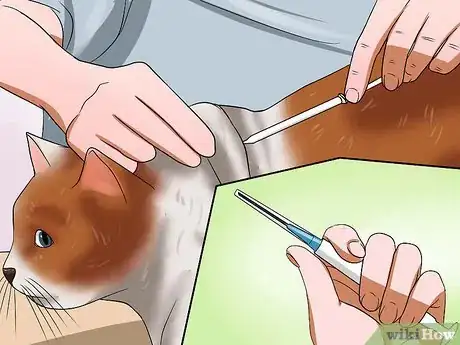This article was co-authored by Pippa Elliott, MRCVS. Dr. Elliott, BVMS, MRCVS is a veterinarian with over 30 years of experience in veterinary surgery and companion animal practice. She graduated from the University of Glasgow in 1987 with a degree in veterinary medicine and surgery. She has worked at the same animal clinic in her hometown for over 20 years.
There are 7 references cited in this article, which can be found at the bottom of the page.
This article has been viewed 41,327 times.
Stray cats—or cats without a permanent home—are a huge problem in the United States. Stray cat numbers are estimated to be up to 70 million in the United States alone.[1] Homeless cats have a very rough and short life. They are prone to contracting disease and to spreading disease; their hunger leads them to kill (among other small animals) songbirds; and they reproduce new stray cats because most of them are not spayed or neutered. You can play a crucial role in helping a stray cat find a good home and having it spayed or neutered to prevent further strays. The job isn't easy and it can cost some in time and money, but it can be a big help to your neighborhood and community even if you only help one stray cat.
Steps
Staying Safe
-
1Determine if the cat is a stray or not. Before you decide to help, you need to determine if the cat is a stray or not. Try to find out if the cat belongs to one of your neighbors. Ask around the neighborhood to see if anyone is missing a cat. Cats escape from homes sometimes and may roam far from their yards.[2]
- Call your local veterinarian and animal shelter to ask if someone has lost a cat similar to the one you think might be a stray.
- Snap a photo with your phone camera and post online on missing pet forums on social media. You could even make up fliers with the photo and post in local stores.
- Care for the stray while you wait for a response.
-
2Be cautious. Stray cats can be wild and unpredictable in their behavior. Approach the stray cat keeping in mind that it may spread disease to both you and any cats you already own. Your first responsibility is to protect yourself.[3]
- Cat bites often become infected and sometimes with serious consequences.
- Wear long sleeves, gloves and pants when you are around an unfamiliar cat. In addition to infections, cat bites can spread rabies. Keep in mind that a cat's sharp teeth can still penetrate gloves and clothing.
Advertisement -
3Be aware of the rabies risk. It's uncommon for even stray cats to carry rabies, but it is a possibility. If you live in an area with wild animals that are known rabies carriers, such as raccoons, bats, skunks, and foxes, you should exercise extra caution.[4]
- Look for aggression, restlessness, and lethargy. It could be difficult to tell the difference between the stray cat's "normal" behavior and unusual behavior.
- Listen for increased vocalization. When cats are suffering from rabies, they may meow or howl more frequently.
- Look for signs of disorientation, paralysis, or seizures.
- You should not attempt to handle or capture a cat who is acting strangely. Instead, report the animal to local animal control officers as soon as you can.
- There is no test to diagnose rabies in live cats. Thus, it is important to exercise caution when interacting with the cat.
- If you are bitten, clean the wound well with soap and water and see your doctor immediately.[5] [6]
-
4Keep stray cats away from your cats. To protect your own cats from any diseases or parasites the stray may be carrying, you should keep strays away from your cats until the strays have been examined by a veterinarian. Stray cats can transmit diseases such as feline leukemia, distemper, rabies, and parasites such as fleas.[7]
- If the cat acts lethargic, has a runny nose and eyes, breathes heavily or acts strange don't approach the cat. These are all signs of disease. If you encounter an unhealthy looking cat, call animal control to have the cat caught by professionals.[8]
-
5Gain the stray cat's trust. Gaining a cat's trust can sometimes be difficult. Setting food out for a stray cat is a good way to start gaining its trust. Try placing wet food and a bowl of fresh water in a protected spot that is not accessible to dogs or other animals like raccoons. Stand or crouch several feet away from the food to let the cat to get him used to your presence.[9]
- If the cat is timid keep leaving the food out for three or more days until it becomes comfortable with you standing or crouching near the feeding spot.
- During this time look for signs of disease and pay attention to the cat's behavior. Does it growl or hiss at you? Does it watch you when you are around? Does it approach you?
- If the cat seems comfortable in your presence, try offering it a little wet food on the tip of a spoon. If it eats off of it, then that means that the cat may be ready to make friends with you.
- Offer it more food on the spoon and slowly reach your hand towards it. See if the cat will let you touch it under the chin. Once the cat allows you to stroke its chin, try stroking other parts of its head.
- Do not attempt to pet or hold a cat that looks aggressive or sick.
Caring for a Stray Cat
-
1Schedule a veterinary visit. After a cat starts to trust you, you will need to take the stray for a checkup with your veterinarian. Make an appointment with your veterinarian for as soon as possible.[10]
- To take the cat to the veterinarian, place him in a cat carrier. This will help to keep the cat safe and secure.
- Make sure that you inform the veterinarian that the cat is a stray. Also, tell the veterinarian if you've noticed any injuries, parasites, or any other health concerns.
- The veterinarian will examine the cat and treat it for any internal or external parasites. The veterinarian will also perform a feline leukemia test by drawing a small amount of blood from the cat's vein. If the test is negative, the veterinarian will administer some vaccines (rabies and distemper) and ask you to schedule the cat to be spayed and neutered.
- If the cat has feline leukemia, you will be given some options. These may include surrendering the cat to a human society for care and adoption, keeping the cat yourself under feline leukemia precautions, or euthanasia. The veterinarian will help you decide which option is best for you.
-
2Decide if you will take ownership of the stray or try to find him a home. Helping stray cats is more than just providing them with some food.[11] Stray cats need help finding homes so that they can lead the best life possible. Sometimes that home is with you; other times the best help you can give a stray cat is to find someone else who can provide for the cat.
-
3Consider joining a trap-neuter-release organization. There are trap-neuter-release (TNR) organizations that will trap stray cats; take them to be neutered or spayed; and then release them back near where they were found. These programs help to keep the cat population under control and it is often a good option for cats that would not make good pets due to being too wild or feral.[12]
- Your veterinarian, local humane society or animal control should be able to tell you if such organizations exist in your area and how to contact them.
Expert Q&A
-
QuestionHow do you capture a stray cat?
 Pippa Elliott, MRCVSDr. Elliott, BVMS, MRCVS is a veterinarian with over 30 years of experience in veterinary surgery and companion animal practice. She graduated from the University of Glasgow in 1987 with a degree in veterinary medicine and surgery. She has worked at the same animal clinic in her hometown for over 20 years.
Pippa Elliott, MRCVSDr. Elliott, BVMS, MRCVS is a veterinarian with over 30 years of experience in veterinary surgery and companion animal practice. She graduated from the University of Glasgow in 1987 with a degree in veterinary medicine and surgery. She has worked at the same animal clinic in her hometown for over 20 years.
Veterinarian There is a variety of humane traps that will capture a cat with minimal stress to the stray. Contact your local animal welfare or cat rescue charity and they should be able to help.
There is a variety of humane traps that will capture a cat with minimal stress to the stray. Contact your local animal welfare or cat rescue charity and they should be able to help. -
QuestionWhat's the coldest weather a cat can survive in?
 Pippa Elliott, MRCVSDr. Elliott, BVMS, MRCVS is a veterinarian with over 30 years of experience in veterinary surgery and companion animal practice. She graduated from the University of Glasgow in 1987 with a degree in veterinary medicine and surgery. She has worked at the same animal clinic in her hometown for over 20 years.
Pippa Elliott, MRCVSDr. Elliott, BVMS, MRCVS is a veterinarian with over 30 years of experience in veterinary surgery and companion animal practice. She graduated from the University of Glasgow in 1987 with a degree in veterinary medicine and surgery. She has worked at the same animal clinic in her hometown for over 20 years.
Veterinarian Stray cats will struggle to survive in the depths of winter, especially when there is snow or the ground is hard frozen. The cat is more likely to survive if they have a dry shelter, out of the wind, and access to drinking water that isn't frozen.
Stray cats will struggle to survive in the depths of winter, especially when there is snow or the ground is hard frozen. The cat is more likely to survive if they have a dry shelter, out of the wind, and access to drinking water that isn't frozen.
Warnings
- Some stray cats can be dangerous, so help with caution or leave it up to animal control to deal with them.⧼thumbs_response⧽
- Vet care can be very expensive, especially for an animal who has never been. If you cannot afford to pay a large veterinarian bill, contact a local shelter or cat rescue group to see if they can help. Many pet shelters have funding for taking stray animals to the vet.⧼thumbs_response⧽
References
- ↑ www.aspca.org/about-us/faq/pet-statistics
- ↑ https://www.aspca.org/pet-care/virtual-pet-behaviorist/cat-behavior/stray-and-feral-cats
- ↑ https://www.aspca.org/pet-care/virtual-pet-behaviorist/cat-behavior/stray-and-feral-cats
- ↑ https://www.aspca.org/pet-care/cat-care/rabies
- ↑ http://www.cdc.gov/features/dsrabies/
- ↑ https://www.aspca.org/pet-care/cat-care/rabies
- ↑ http://pets.webmd.com/cats/helping-stray-and-feral-cats
- ↑ www.feralcat.com/trapinst.html#A1.1
- ↑ https://www.aspca.org/pet-care/virtual-pet-behaviorist/cat-behavior/stray-and-feral-cats
About This Article
Before you help a stray cat, make sure that it’s really a stray by asking your neighbors or putting up signs with the cat’s picture on them.While you wait for a response, gain the cat's trust by setting out some wet food and fresh water every day, and crouching several feet away from the cat while it eats to get it used to your presence. If no one claims the cat after a few days, take it to the vet for an examination and vaccines. Then, decide whether you want to keep the cat or bring it to a shelter where they will try to re-home it. For tips from our Veterinary reviewer on how to keep your other cats safe while you care for a stray, read on!




































































